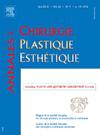[对 10 名纯腕关节周围脱位患者进行至少 18 年的随访]。
IF 0.5
4区 医学
Q4 SURGERY
引用次数: 0
摘要
目的长期评估无骨关节病变的腕关节后脱位患者的功能能力和骨关节炎的发生情况:这是一项单中心回顾性观察研究,研究对象是瓜德罗普大学医院因腕关节后周脱位而接受手术治疗的患者,随访时间至少18年。研究共纳入了 10 名患者,平均随访时间为 22.8 年。评估标准包括临床(PRWE、QuickDASH、疼痛、握力、腕关节活动度、Watson和Reagan测试、库尼功能评分)和影像学(Gilula曲线、腕骨高度、腕骨尺侧平移、肩胛骨与桡骨的夹角、肩胛骨与三叉月椎间线的静态和动态、赫茨伯格并发症分类):平均库尼评分为 67.5/100。PRWE 和 QuickDASH 平均得分分别为 33.9 分和 24.8 分。受伤一侧的平均屈伸弧度为 71.5°(与健康一侧相比为 66.7%)。平均握力为27公斤(与健侧相比为72.8%)。骨关节炎的发病率为60%,根据赫茨伯格标准,有3个A型、2个A1型、1个B型和4个B1型:影响长期预后的因素包括月骨的初始移位、截骨的质量以及是否存在慢性腕关节不稳定,尤其是肩胛骨不稳定。在我们的系列研究中,骨关节炎的高发病率(60%)显然与患者的长期功能能力无关:4:本文章由计算机程序翻译,如有差异,请以英文原文为准。
Revue à 18 ans de recul minimum, de 10 patients présentant une luxation périlunaire isolée du carpe
Objectif
Évaluer les capacités fonctionnelles et la survenue d’arthrose à long terme chez des patients pris en charge pour des luxations périlunaires postérieures sans lésions osseuses (LPL).
Hypothèse
La survenue d’une luxation périlunaire du carpe est associée à un haut risque d’arthrose du carpe à très long terme.
Patients et méthode
Il s’agissait d’une étude observationnelle rétrospective monocentrique sur des patients opérés au CHU de Guadeloupe pour une luxation périlunaire du carpe sans lésions osseuses associées avec minimum 18 ans de recul. Dix patients ont été inclus avec un recul moyen de 22,8 ans. Les critères d’évaluation étaient cliniques (PRWE, QuickDASH, douleur, force de préhension, mobilités articulaires du poignet, tests de Watson et de Reagan, score fonctionnel de Cooney) et radiographiques (courbes de Gilula, hauteur du carpe, translation ulnaire du carpe, angles scapho-lunaire et radio-lunaire, interlignes scapho-lunaire et triquetro-lunaire en statique et en dynamique, classification des complications de Herzberg).
Résultats
Le score de Cooney moyen était de 67,5/100. Les scores PRWE et QuickDASH moyens étaient de 33,9 et 24,8 respectivement. L’arc moyen de flexion-extension du côté lésé était de 71,5° (66,7 % du côté sain). La force de préhension moyenne était de 27 kg (72,8 % du côté sain). La prévalence de l’arthrose dans la série était de 60 %, avec trois types A, deux types A1, un type B et quatre types B1 selon Herzberg.
Conclusion
Les facteurs influençant le pronostic à long terme sont le déplacement initial du lunatum, la qualité de la réduction et la présence d’une instabilité chronique du carpe notamment scapho-lunaire. La prévalence importante de l’arthrose dans notre série (60 %) n’est apparemment pas corrélée aux capacités fonctionnelles des patients sur le long terme.
Niveau de preuve
4.
Objective
To evaluate, in long-term, the functional abilities and the occurrence of osteoarthritis in patients treated for a posterior perilunate carpal dislocation without bone lesion associated.
Patients and method
This was a monocentric retrospective observational study on patients operated on at the University Hospital of Guadeloupe for a posterior perilunate dislocation without bone lesion associated with a minimum of 18 years of follow-up. Ten patients were included with a mean follow-up of 22.8 years. The evaluation criteria were clinical (PRWE, QuickDASH, pain, grip strength, wrist joint mobility, Watson and Reagan tests, Cooney functional score) and radiographic (Gilula curves, carpal height, carpal ulnar translation, scapholunate and radiolunar angles, scapholunate and triquetro-lunar interlines in statics and dynamics, Herzberg's classification of complications).
Results
The average Cooney score was 67.5/100. Mean PRWE and QuickDASH scores were 33.9 and 24.8 respectively. The mean flexion-extension arc on the injured side was 71.5° (66.7% compared to the healthy side). Mean grip strength was 27 kg (72.8% compared to the healthy side). The prevalence of osteoarthritis was 60%, with three A types, two A1 types, one B type and four B1 types according to Herzberg.
Conclusion
The factors influencing the long-term prognosis are the initial displacement of the lunate, the quality of the reduction and the presence of chronic carpal instability, particularly scapholunate. The high prevalence of osteoarthritis in our series (60%) is apparently not correlated with the functional capacities of patients over the long term.
Level of evidence
4.
求助全文
通过发布文献求助,成功后即可免费获取论文全文。
去求助
来源期刊
CiteScore
1.00
自引率
0.00%
发文量
86
审稿时长
44 days
期刊介绍:
Qu''elle soit réparatrice après un traumatisme, pratiquée à la suite d''une malformation ou motivée par la gêne psychologique dans la vie du patient, la chirurgie plastique et esthétique touche toutes les parties du corps humain et concerne une large communauté de chirurgiens spécialisés.
Organe de la Société française de chirurgie plastique reconstructrice et esthétique, la revue publie 6 fois par an des éditoriaux, des mémoires originaux, des notes techniques, des faits cliniques, des actualités chirurgicales, des revues générales, des notes brèves, des lettres à la rédaction.
Sont également présentés des analyses d''articles et d''ouvrages, des comptes rendus de colloques, des informations professionnelles et un agenda des manifestations de la spécialité.

 求助内容:
求助内容: 应助结果提醒方式:
应助结果提醒方式:


